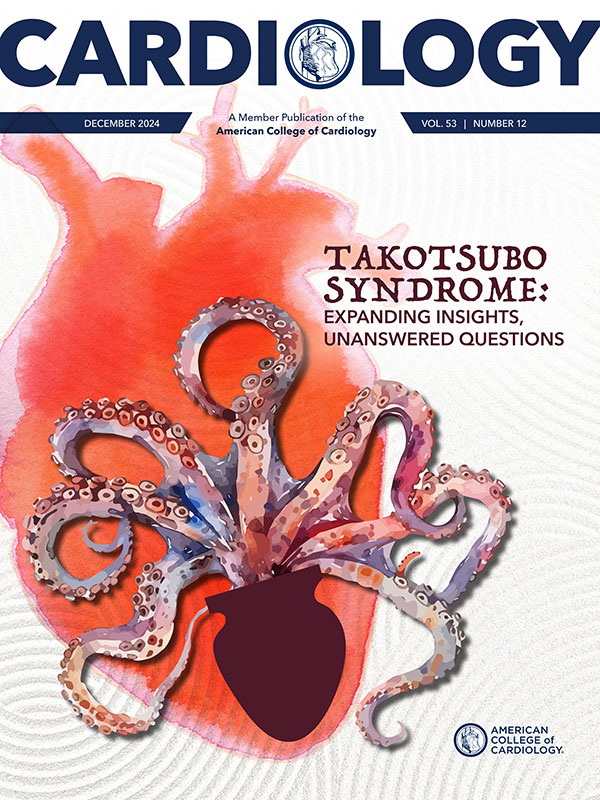From the Member Sections | Transformative Trends Shaping the Future of the Business of Cardiology

Cardiovascular medicine is at a crossroads, navigating the dual pressures of an aging population and an evolving health care landscape. The business of cardiology, in particular, is being reshaped by a myriad of cultural and technological trends.1
These forces are not only altering how cardiovascular care is delivered but also challenging long-standing norms regarding how physicians engage with their work; patient expectations regarding their health, data and experiences; as well as the financial structures that support cardiovascular care.
Cultural Shifts in Cardiology: Redefining Roles and Workflows
Burnout, Mental Health and the Physician Workforce Crisis: The Changing Clinical Mindset
The topic of burnout in medicine has moved from a whisper to a roar, and cardiology is no exception. Increasing administrative tasks, high patient volumes and the relentless pace of technological change have left many cardiologists grappling with challenges.
The demand for cardiovascular care is skyrocketing, particularly with a projected 25% increase in the Medicare population over the next decade, yet the number of practicing cardiologists is dwindling.2 Early retirements, burnout and shifts toward part-time or reduced hours (e.g., <1.0 FTE) are exacerbating this gap.

Physicians today grapple with a growing administrative burden, reduced autonomy, and increasing pressure to maintain and even increase already high patient volume in the face of declining reimbursement rates.
These challenges are driving many clinicians away from what was once seen as a calling and into the arms of corporatized medicine – or out of the profession altogether.3
Addressing this workforce crisis requires more than just individual-level interventions; it demands system-wide changes that prioritize the quadruple aim of high-value care that improves patient health, patient experience and the clinician work-life experience.4
Workflow Evolution: From Time to Listen to the 15-Minute EHR Visit
One of the most pronounced cultural shifts in cardiology and all of medicine is the transformation of patient visits. Time spent with patients is shrinking, often reduced to 15-minute EHR-driven visits, where physicians are required to focus as much on data entry as listening to their patients.5
This change exacerbates physician (and patient) frustration, limiting meaningful patient interactions and reducing the art of medicine to a checklist.
This shift is detrimental to the patient experience and the physician-patient relationship. As clinicians struggle to balance EHR demands with patient care, many are turning to new strategies – such as scribing, team-based approaches and concierge models – to restore a sense of autonomy and depth in their interactions.
From Fee-For-Service to Value-Based Care: A Necessary Evolution
The ongoing transition from fee-for-service (FFS) to value-based care models is redefining the financial landscape of cardiology. While FFS incentivized volume, value-based care models are intended to push cardiologists to focus on patient outcomes, cost reduction and long-term disease prevention.

Implementing true value-based care remains a challenge, however, particularly in defining high-value services and ensuring adequate reimbursement for delivering them.6
As Medicare Advantage continues to grow, many cardiologists find themselves navigating the complexities of utilization management and reimbursement models that often prioritize cost savings over quality outcomes.
Despite the promise of value-based care, inefficiencies persist, particularly when it comes to translating policy into better patient care. The rapid expansion of Medicare Advantage plans, while financially attractive to insurers and private equity, raises questions about the long-term societal value and sustainability of such models.
The Rise of Physician-Administrators: Business Skills in Clinical Settings
Another major cultural trend is the increasing number of cardiologists obtaining business or administrative degrees such as MBAs or MHAs.7 With the rise of large integrated health care systems, many physicians are now taking on leadership roles that require a deep understanding of finance, strategy and operations.
This trend reflects the growing recognition that clinical expertise alone – and by the same token administrative experience alone – is no longer enough to navigate the complexities of modern health care.
As more cardiologists take on administrative roles, they are uniquely positioned to advocate for policies and practices that improve patient care while also ensuring financial sustainability. The rise of the physician-administrator is reshaping how decisions are made, bringing a clinical perspective to the business of health care.
The Return to Private Practice: A Reawakening
After a decade marked by the consolidation of private practices into larger health systems, the pendulum may be starting to slowly swing back toward independent practice.
The democratization of EHR systems, the rise of artificial intelligence (AI) and the growth of concierge-style care models are enabling more cardiologists to return to private or solo practice. These practices offer greater flexibility, autonomy and the opportunity for deeper patient engagement.
Private equity's growing involvement in cardiology practices has also provided them with financial backing, though it comes with risks, such as potential debt burdens and operational control that could lead to cost-cutting at the expense of care quality.8
While private equity brings efficiency and investment, its shorter-term investing horizon raises concerns about long-term sustainability and effect on patient care and quality. This is an area of ongoing evaluation.
Technological Innovation: Powering the Future of Cardiology
AI and Machine Learning: The New Frontier in CV Care
AI and machine learning (ML) are on the path to revolutionize cardiology, driving innovations in diagnostics, risk stratification and personalized treatment plans.

AI-powered tools are improving clinical outcomes by enabling faster and more accurate diagnoses, particularly in imaging, electrophysiology and genomics. Advances in natural language processing (NLP) are proving instrumental in automating routine tasks, such as automatically creating clinic notes and appropriate billing codes from recorded audio, allowing cardiologists to refocus their time and energy on patient care.9
AI's potential extends beyond the patient-facing interactions.10 It has the potential to help reduce administrative burdens by automating routine tasks like billing, coding and appointment scheduling.
Fully integrating AI into clinical practice, however, requires a thoughtful approach to ensure that these tools enhance, rather than hinder, the health care workforce and patient care while also ensuring data and patient privacy.
AI algorithms also have the potential for bias and other ethical concerns, especially when trained on nonrepresentative datasets.11 If an AI model is developed using data from primarily one demographic (e.g., white, middle-aged men), its predictions may be less accurate or even harmful when applied to other populations such as women or minorities.
Addressing this issue requires systems in place ensuring diverse representation in training datasets and continuous validation of AI models across different patient populations.
Looking ahead, the future of AI in cardiology appears to be one of collaboration between human expertise and machine intelligence. AI will not replace cardiologists; rather, it will serve as a powerful tool that enhances their decision-making capabilities.
As AI tools continue to improve, cardiologists will be able to offer more personalized, precise care tailored to the individual patient's needs. As such, ongoing education and training will be necessary to prepare cardiologists to effectively use AI in their practice.
Telemedicine and RPM: A Permanent Shift
The COVID-19 pandemic accelerated the adoption of telemedicine and remote patient monitoring (RPM), particularly in chronic disease management. Telemedicine is becoming indispensable in managing cardiovascular diseases like heart failure, arrhythmias and hypertension.12
Wearable and remote sensors offer real-time monitoring, enabling cardiologists to detect early signs of deterioration, intervene proactively and in doing so potentially reduce costs associated with increased disease burden and hospitalization.
The integration of AI-powered tools into telemedicine platforms is enhancing the quality of remote consultations by providing clinicians with decision support tools that can analyze patient data in real time, though challenges remain in terms of integration and accuracy.13
MedAxiom CV Transforum Fall'24 Reaches New Heights in CO
MedAxiom hosted its CV Transforum Fall'24 conference Oct. 17-19, 2024, in Denver, CO, uniting hundreds of thought leaders and clinicians from across the country for three days of discussion and networking around topics like team-based care, technology integration, best practices for reducing administrative burden and streamlining care delivery, leadership and more.
The conference kicked off with a keynote session on the "Simplification of Cardiovascular Care" delivered by Jaime Murillo, MD, FACC, senior vice president and chief medical officer at Medical Affairs, UnitedHealth Group. During the keynote, Murillo explored modern strategies to streamlining cardiovascular care delivery.
In another session, Andy Tomaszewski, director of Strategic Consulting at Google, drew on real-world, health care incident response experience to offer front-line cybersecurity lessons for health care leaders.
Other session highlights included a closer look at private equity and management services organizations, tips for gauging the feasibility of developing an ambulatory surgery center, a deep dive into innovations in virtual care, and more.
"We are witnessing a transformative shift in health care, where nonclinical competencies are no longer optional but essential for success," said MedAxiom President and CEO Jerry Blackwell, MD, MBA, FACC. "CV Transforum brings together top health care leaders to spearhead advancements in cardiovascular care, offering actionable solutions to seamlessly integrate cutting-edge innovations into care delivery models and leverage technology to enhance population health outcomes."

Whether it's helping interpret home-recorded ECGs or guiding therapeutic decisions based on RPM data, AI augments the capabilities of cardiologists to deliver high-quality care at a distance.
This shift is not temporary. When utilized appropriately, it promises to enhance patient outcomes while reducing costly interventions such as unnecessary in-person visits, emergency visits and hospitalizations. This model has particular value in rural or underserved areas where access to cardiologists is often limited.
Telemedicine platforms enable cardiologists to consult with patients from across vast geographic distances, reducing barriers to care. The challenge moving forward will be integrating these tools into everyday clinical workflows, ensuring that this data is accurate and can be effectively analyzed and acted upon.
Precision Medicine: Tailoring Treatments
Cardiology is increasingly embracing precision medicine, driven by advancements in genomics and molecular diagnostics.14 Genetic testing is enabling more tailored treatment plans, particularly for conditions like cardiac amyloidosis, various cardiomyopathies and familial hypercholesterolemia.
This move toward personalized care promises the potential of better outcomes, though it also presents challenges in terms of cost, access, equity and ensuring widespread adoption.
Advanced Imaging and Diagnostics: Expanding the Arsenal
The expansion of advanced imaging tools like PET, cardiac CT, cardiac MRI, and 3D echocardiography is transforming how cardiovascular diseases are diagnosed and treated. These tools offer unprecedented clarity, enabling improved evaluation and sensitivity.
Furthermore, AI-guided imaging has the potential to improve diagnostic efficiency and accuracy and to democratize this technology outside of the ivory tower, improving access to care.15
There remains upfront cost and investments which often remain a barrier for widespread use; however, continued research will aid in lowering these adoption barriers.
Digital Health and Virtual Rehabilitation: Bridging Gaps in Care
Digital health platforms are increasingly being used to manage chronic cardiovascular conditions and support post-acute care.

For example, virtual cardiac rehabilitation programs enable patients to engage in tailored rehabilitation programs from the comfort of their homes, increasing participation rates and improving long-term outcomes.16
As the cardiology field continues to embrace digital solutions, the future promises more personalized, efficient and patient-centered care. There remains, however, a need to ensure equitable access to these technologies, particularly for underserved populations.
Navigating the Path Forward
As cardiology continues to evolve, the interplay between cultural and technological shifts will define its future. From the growing recognition of burnout and the move toward more flexible working arrangements to the adoption of AI, telemedicine and precision medicine, cardiologists are adapting to a rapidly changing landscape.
Addressing workforce shortages, refining value-based care models and integrating new technologies will be critical in shaping a sustainable and successful future for the business of cardiology.
The key to navigating these challenges lies in the cardiologists themselves – those who are willing to embrace change, adopt new tools, and redefine the art and business of cardiovascular care.
This article was authored by the Leadership Council of the Cardiovascular Management Member Section. A special thanks to Mustafa Husaini, MD, FACC; Matthew Pierce, MBA, MD; Efstathia Andrikopoulou, MD, FACC; Amy A. Brownwell, FNP-C, AACC; Joseph A. Goeke IV, MD, FACC; and Toniya Singh, MBBS, FACC.
Click here to learn about and join this Member Section and more.
References
- Husaini M, Kisling A, Gupta T, Wasfy J, Biga C. CV Management Deep Dive: Navigating Ongoing Population and Workforce Trends. Cardiology; June 2024. Available here.
- Centers for Medicare and Medicaid Services. 2022 Annual Report of The Boards of Trustees of the Federal Hospital Insurance and Federal Supplementary Medical Insurance Trust Funds. Available here.
- Rosenbaum L. On calling - from privileged professionals to cogs of capitalism? N Engl J Med 2024;390:471-5.
- Huang X, Rosenthal M, Sauer J. Workforce in Crisis: Charting the Path Forward. June 2023. Available here.
- Rabin Roni Caryn. 15-minute doctor visits take a toll on patient-physician relationships. PBS News; April 21, 2014. Available here.
- Husaini M, Joynt Maddox KE. Paying for performance improvement in quality and outcomes of cardiovascular care: Challenges and prospects. Methodist Debakey Cardiovasc J 2020;16:225-31.
- Stuart C. MD/MBAs: Fixing Hearts & Healthcare. Cardiovascular Business; Feb 27, 2013. Available here.
- Bartlett V, Liu M, Ati S, et al. Private equity acquisitions of outpatient cardiology practices in the United States, 2013-2023. JACC 2024;10:953-6.
- Machteld J, Boonstra DW, Moore JH, et al. Artificial intelligence: revolutionizing cardiology with large language models, Eur Heart J 2024;45:332-45.
- Khera R, Oikonomou E, Nadkarni G, et al. Transforming cardiovascular care with artificial intelligence: From discovery to practice: JACC state-of-the-art review. JACC 2024;84:97-114.
- Mooghali M, Stroud AM, Yoo DW, et al. Trustworthy and ethical AI-enabled cardiovascular care: a rapid review. BMC Med Inform Decis Mak 2024;24:247.
- Takahashi EA. An overview of telehealth in the management of cardiovascular disease: A scientific statement from the American Heart Association. Circulation 2022;146:e558-e568.
- Sharma S, Rawal R, Shah D. Addressing the challenges of AI-based telemedicine: Best practices and lessons learned. J Educ Health Prom 2023;1:338.
- Sethi Y, Patel N, Kaka N, et al. Precision medicine and the future of cardiovascular diseases: A clinically oriented comprehensive review. J Clin Med 2023;12:1799.
- Miranda I, Luz JM, Pereira AR, Augusto JB. Artificial Intelligence in Cardiovascular Imaging Algorithms – What is Used In Clinical Routine?" ESC CardioPractice; April 2, 2024. Available here.
- Golbus JR, Lopez-Jimenez F, Barac A, et al. Digital technologies in cardiac rehabilitation: A science advisory from the American Heart Association. Circulation 2023;148:1:95-107.
Clinical Topics: Prevention, Stress
Keywords: Cardiology Magazine, ACC Publications, Mental Health, Telemedicine, Digital Technology, Burnout, Psychological, Burnout, Professional
